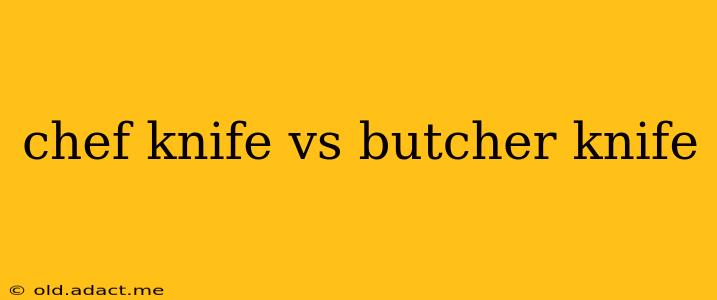Choosing between a chef's knife and a butcher knife can feel overwhelming, especially for home cooks. Both are essential kitchen tools, but their designs and intended uses differ significantly. This comprehensive guide will dissect the key distinctions, helping you determine which knife—or perhaps both—best suits your culinary needs.
What is a Chef's Knife?
The chef's knife, often called a cook's knife, is the workhorse of most kitchens. Its versatility is unparalleled. This typically 8-inch blade (though sizes vary) boasts a curved profile, allowing for rocking motions to finely chop, dice, mince, and slice a wide array of ingredients, from vegetables to proteins. The pointed tip facilitates precise work like piercing and trimming.
Advantages of a Chef's Knife:
- Versatility: Handles a multitude of tasks with ease.
- Precision: The curved blade and pointed tip allow for fine control.
- Efficiency: Rocking motion speeds up food preparation.
Disadvantages of a Chef's Knife:
- Not ideal for heavy-duty tasks: Can struggle with very tough cuts of meat or large bones.
- Can be unwieldy for smaller hands: Larger sizes can be difficult to maneuver for some users.
What is a Butcher Knife?
The butcher knife, also known as a breaking knife, is designed for power and precision when processing raw meat. Its blade is typically longer and more robust than a chef's knife, often straight or with a slight curve, and its thicker profile allows it to cut through bone and tough connective tissues with ease. The blade’s length provides excellent reach and leverage.
Advantages of a Butcher Knife:
- Power: Breaks down large cuts of meat and bone with minimal effort.
- Strength: Durable construction withstands heavy-duty use.
- Precision Cutting: The straight blade is ideal for making clean cuts.
Disadvantages of a Butcher Knife:
- Less Versatile: Primarily for butchering; not ideal for delicate tasks like mincing or dicing.
- Heavy and unwieldy: Can be cumbersome for smaller or less experienced users.
- Can be expensive: High-quality butcher knives are often pricier than chef's knives.
Chef Knife vs. Butcher Knife: Key Differences Summarized
| Feature | Chef's Knife | Butcher Knife |
|---|---|---|
| Blade Shape | Curved | Straight or slightly curved |
| Blade Length | Typically 8 inches (varies) | Typically 6-15 inches (varies) |
| Blade Thickness | Relatively thin | Relatively thick |
| Primary Use | Chopping, dicing, mincing, slicing | Breaking down meat, cutting through bone |
| Versatility | High | Low |
| Weight | Lighter | Heavier |
What Size Chef's Knife Do I Need?
The ideal size of a chef's knife depends on your hand size and cooking style. An 8-inch chef's knife is a popular choice for its versatility. Smaller hands might prefer a 6-inch knife, while larger hands might find an 8- or even 10-inch knife more comfortable.
What Size Butcher Knife Do I Need?
Butcher knife sizes vary greatly. A smaller 6-inch butcher knife might suffice for smaller poultry or game, while larger 12-15 inch knives are ideal for breaking down large cuts of beef or pork.
Do I Need Both a Chef's Knife and a Butcher Knife?
For most home cooks, a high-quality chef's knife is sufficient for the majority of tasks. However, if you frequently process large cuts of meat or bone, a butcher knife is a worthwhile investment. It’s about assessing your cooking habits and priorities.
Which Knife is Best for Me?
Ultimately, the "best" knife depends on your individual needs and cooking style. Consider what you most often prepare. If it’s mostly vegetables, fruits, and smaller cuts of meat, a chef's knife will likely suffice. If you regularly process whole chickens, large roasts, or butcher your own game, a butcher knife is essential. Don't be afraid to invest in both; they are valuable tools in any well-equipped kitchen.
